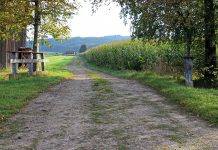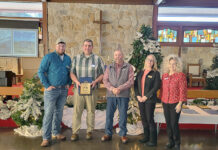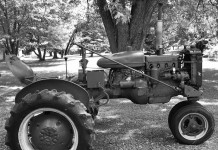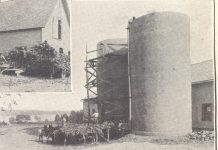How many times have I driven Route 30 through Canton, Ohio, and passed the big Timken factory with its many tin stacks topped by conical caps?
Of course, I’m familiar with Timken High School and Timken Mercy Hospital (now Mercy Medical Center) in that city.
I know that for many years, the city of Canton and the Timken firm have been inextricably intertwined, and I always figured the original Timken got his start right there in Canton.
However, tain’t so.
In the beginning
Henry Timken was born Aug. 16, 1831, on a farm near Bremen, Germany. His mother died in 1837, and in 1838 his father, Jacob, emigrated to America with Henry and six siblings in tow. After losing a lot of money to a crooked religious leader, Jacob Timken bought, for $1,150, 680 acres west of Sedalia, Mo., where a group of fellow Germans had settled.
Henry went to the local country school and, along with his sister and brothers, worked hard to make the farm productive. At 16, Henry was apprenticed to a master wagon and carriage maker in St. Louis and he spent the next eight years becoming thoroughly familiar with the trade, before going into the carriage building business on his own in 1855.
Then, in 1860, the western gold fields called and Henry went to Colorado to make his fortune, although, like so many others, he came home broke.
Returning to business
During the Civil War, he enlisted in the Union Army, rising to the rank of captain. After the war, Timken returned to the carriage making business, which had changed dramatically.
Under the spur of war-time production demands, machine tools had replaced the hand methods that had been learned so well by Timken.
He, however, enthusiastically adopted the new technology and, after his original shop in St. Louis burned, Henry built a new one containing many of the new machines.
New tech
The new machinery brought the cost of carriages down to the point where, it was said, every man who could afford a horse, could afford a good buggy.
Improvements
Timken continuously improved his products. In 1876, he and a man named Ethen Allen Jones patented a folding seat for light wagons or buggies. A year later, Timken patented a spring system that involved side rails.
Business boomed and Timken had to build a new and larger factory in 1877.
Timken advertised and promoted the new spring arrangement relentlessly and by 1881 it was reported that hundreds of thousands of Timken cross-springs were in use, resulting in another factory expansion.
Brief retirement
He then retired to San Diego, but found inactivity weighing heavily upon him.
So, after five years of traveling, Timken got back into the carriage game, patenting several improvements in vehicle springs, one of which won a First Premium at the 1893 Chicago World’s Fair.
Meanwhile, anti-friction ball bearings had been developed in the U.S. for bicycles, but it was difficult to keep the balls in place.
Long straight roller bearings had been in use in farm implements for several years — having been first used by the Deering Harvester Company — but these were suitable only for low speeds, such as on the axles of grain binders and hay mowers.
Better bearings
Timken recognized the need for better bearings for the higher speeds of carriages and, during the 1890s, had become aware of the new “horseless carriages,” such as those of the Duryea brothers.
Timken and his son, Henry H., traveled abroad in the mid 1890s and studied the development of bearings in Europe, which was ahead of this country.
Upon returning to the States, Timken turned his efforts to developing a better roller bearing. There were many patents for tapered roller bearings in Europe and the U.S., dating back to the early 1800s, but none had met with much success.
Timken, with the help of his sons and a couple of nephews with the surname Heintzelman, applied for their first patent for a roller bearing in 1897, and a second in 1898.
Success
After testing in actual use on the carriages of several friends, the new design was deemed a success and The Timken Roller Bearing Axle Company was incorporated in 1899.
With the start of the new firm under the management of his sons, William and Henry H., Henry Timken re-retired to San Diego, where this time, he seems to have found enough to keep himself content.
At first, the higher price of Timken bearing equipped axles limited the appeal for carriage buyers, however, the fledgling automobile industry showed signs of taking off and the Timken brothers decided they would cast their lot with autos.
Moving east
However, they needed to be nearer the action.
Although several towns wanted them, the Timkens chose Canton, Ohio, partly because H.H. Timken was a friend of Gordon Mather, president of the Canton Board of Trade, but primarily because Canton was near steel mills, coal deposits, railroads and the burgeoning automobile industry centered around Cleveland and Detroit.
Canton
The new Timken Roller Bearing factory, located on Dueber Avenue in Canton opened on December 2,1901 with forty employees.
The first years were lean and they had to borrow money from their father in San Diego to keep afloat.
They hired a young salesman named Eugene Lewis, who proved to be one of their greatest assets. By 1905, the Timkens could barely keep up with demand and kept improving their product and manufacturing methods.
They gauged every roller and improved the grinding process until, by 1908, there was not more than .001 of an inch difference.
That was about the time that Henry Leland of Cadillac began to buy bearings from Timken.
To quote the old cliche, the rest is history.
Roller bearings became an indispensable part of nearly every machine built world wide and, although there are other bearing manufacturers, the Timken name is stamped on a big part of those bearings.
(Send suggestions, comments or questions to Sam Moore in care of Farm and Dairy, P.O. Box 38, Salem, OH 44460-0038; or via e-mail to: editorial@farmanddairy.com.)












